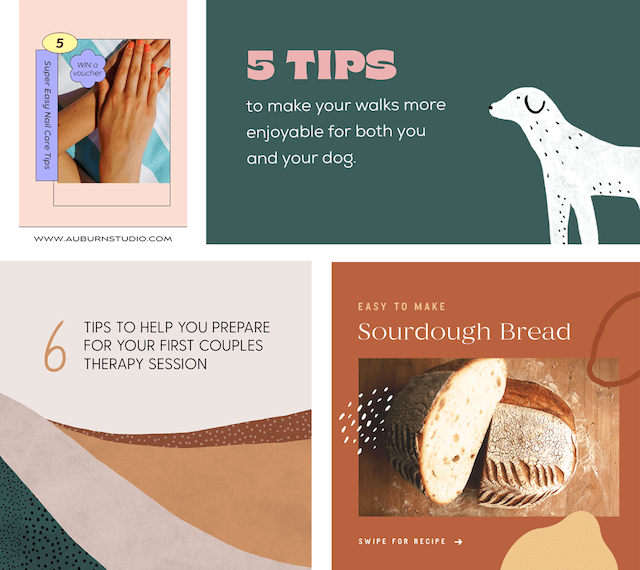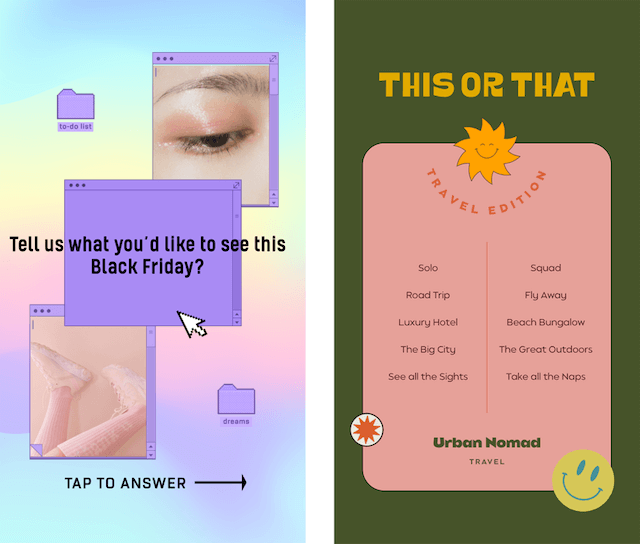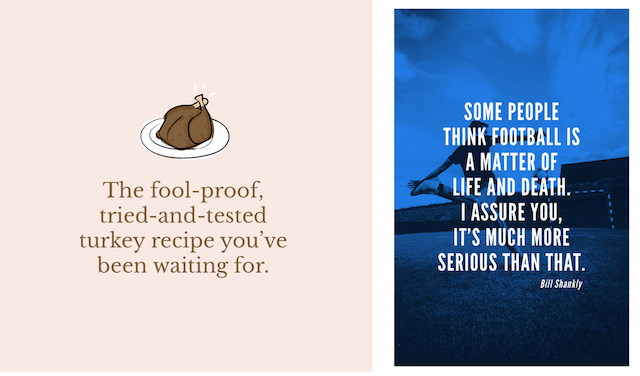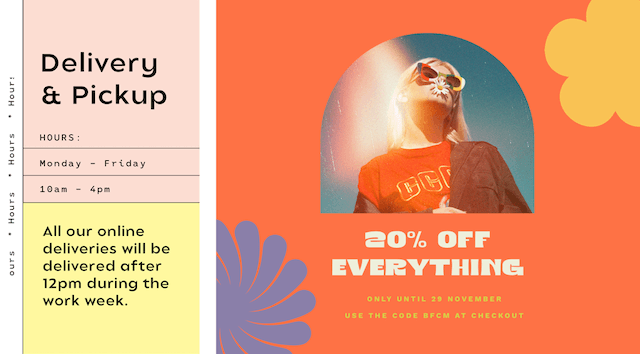
When it comes to brand communications – whether it’s through a website, a mailer, a display advertisement or an Instagram Story – the visuals are only half the battle. The other equally important half is the copy. That’s why it’s important to brush up on the latest copywriting tips to ensure your advertisements portray a clear message.
When designing, you’ll need to think about the words you use alongside, below, or within your ad. This will help qualify what you’re saying and drive a message home to your target market.
Remember, a pretty picture doesn’t necessarily mean much unless it’s accompanied by some sort of copy for context.
For example, think about an image-heavy platform like Instagram. People often leverage their content with a written caption under each post. Pairing this with visual branding makes your message impactful – especially for folks who like to read copy to get more details. It may even give someone that final nudge to make a particular purchasing decision.
Successful ad content maximizes the power of both words and images.
It creates harmony to craft a targeted message that evokes a particular feeling. This tango between art and copy is the backbone of most traditional advertising. And a good team will often consist of a Copywriter and Art Director working in tandem to develop ideas.
Key copywriting tips to boost your content game
Now that we’ve established the importance of copy to your brand communications, it’s time to build up your copywriting skills. Here are 10 copywriting tips to help your ads resonate and most importantly sell.
1. Create a narrative arc
Like any good story, copy works best when there’s a narrative arc present. A newsletter, for example, should contain a beginning, middle and end. The same goes for a blog post or even a captivating Instagram caption. Think of the structure like this:
- Beginning: An introduction to guide your audience through
- Middle: Content that’s substantial, but not overwhelming
- End: A conclusion that ties everything together and leaves your audience feeling satisfied, inspired or wanting more.
Crafting your copy in this way helps paint a picture that can really hit home with the person reading it. Visual tools are constantly evolving and a properly crafted narrative can help you pull the customer along. Advancements likecarousels in Instagram can help encourage viewers to scroll to the next slide.
Similarly, you can produce video content with the same arc. Start by introducing the topic and drawing the reader in. Then, deliver your main message (or call to action) and end with something memorable or punchy.

2. Calls-to-action
At the end of the day, sales copy is only as good as the actions your customers take to engage with it. Your goal may be to sell something, but your message may need to be more subtle.
One way to do this is to create brand awareness.
For example, your copy should encourage your audience to do something at the end. Think of what you’d like to accomplish and consider the following questions:
- Is it to subscribe to your email database for future updates?
- Aiming to have them buy a product?
- How about getting them to browse your website?
- Should you ask them to give their opinion on your next product?
Whatever your goal is, it’s important to make their next step in the customer journey super obvious and super easy.

3. Keep your customer engaged
We’re in an attention-driven economy, where brands are constantly vying for consumers’ eyes, hearts and wallets. Any content you write needs to offer the consumer something in return. This could include:
- Information that’s helpful to their lives or something educational
- A highly unusual or thought-provoking post
- Something that’s extremely relevant to the time
- An entertaining post that’s funny or light-hearted
You could even consider a blend of the concepts above. Just make sure you’re not writing filler text for the sake of taking up space. You don’t want to broadcast irrelevant information to your potential customers.
Instead, focus on the engagement. Think about what you want to say and how you can say it in a way that keeps your customer’s time in mind. This will help encourage viewers to read your message and, hopefully, take action.

4. Know your target audience
If you know who you’re marketing to, you’ll be in a better position to make more sales. The key is to know your target audience’s pain points, needs, and desires.
To solve these, you’re going to need to do a little research. Find areas where you can help and offer them things like:
- Information
- Resources
- Price deals that’ll suit their budget
Combining graphics and copy helps build a strong line of communication between you and your audience. Take time working out who it is you’re talking to and the language they respond to. Examples of different languages styles could include:
- Formal
- Informal
- Chatty
- Businesslike
Remember, the approach you take should be relevant to your brand. You’ll want to take proactive measures to stay ahead of the game. You can do this by:
- Conducting marketing research (surveys or polls)
- Spending time where your customers are online
- Noting what they respond to and how they engage with the world
Make sure that what you’re saying resonates with them. That way they’ll be more likely to continue interacting and buying from you.

5. Headlines are crucial
The headline will be what draws your user in first and grabs their attention. It should spark interest in just a few words while giving your audience an accurate idea of what the rest of the content is about. This also applies to subheaders within your post (to a lesser extent) and should maintain consistency throughout the text.
In other words, they should be closely related. You can get creative here, but don’t get too obscure or abstract. If you do, make sure that your subheading is close by to qualify what your headline says. You can apply these concepts to copy you create for:
- Flyers
- In-store posters
- Banner ads
- Instagram posts
- Page on your website
Remember, the more strategic you are with headlines the better equipped you’ll be at capturing your audience’s attention.

6. Get your grammar right
Grammar may not be top of mind, but mistakes in your writing reflect badly on your brand. That’s not to say you can’t write informally on occasion. Sometimes jargon or slang can be effective in certain situations.
But it’s always important to remember the basics of sentence structure, punctuation and spelling.
Clean copy can show your customer’s that you’re credible and trustworthy. They often seek this reassurance before they part with their hard-earned dollars for your product or service.
Even if it’s on a subconscious level, good writing can go a long way. That’s why you should always double-check whether it’s “your” or “you’re”; “it’s” or “its.” Taking a minute or two to double-check these things can make all the difference between sounding professional, or sub-consciously sketchy.

7. Be specific
A vague approach is the enemy when it comes to sales copy. Now is not the time to be abstract. If you’re talking about a new offering, make sure to be specific about:
- What it is
- What its features are
- Why your customers should buy it
If you’re communicating about a sale or special offer, try to spell out the details rather than leave your customers guessing. The last thing you want to do is make them confused.
Instead, keep it simple and don’t over-complicate your writing when explaining things. Focus on shortening sentences in the active voice (see below) and use visual aids like lists and bullet points to make your message even clearer.
In turn, shaving an extra ten seconds off your copy helps keep your audience engaged – especially in the age of short attention spans.

8. Use the active rather than passive voice
As we mentioned above, sales copy is all about getting your customer to do something. That’s why a key copywriting tip is to write in the active voice rather than the passive whenever possible.
For example, “Buy two items today and get 15% off!” is far more powerful than “15% off every two items purchased.” It subconsciously etches an action into our minds, as opposed to a concept.
The act of buying something is a lot more vivid than the concept of something being on sale.
Although the difference is subtle, it’s an all-important tool in customer engagement — especially in those precious moments between consideration and purchase.

9. Sell the sizzle, not the steak
This is an old concept, but it’s worth repeating: When trying to sell something, emphasize its benefits over its features. Focus on the details that show how it makes your customers’ lives better, simpler, or more fun.
For example, let’s say you own a juice shop. Instead of listing the fruits and vegetables in your pressed juices, talk about how the vitamins and minerals from each ingredient can benefit someone’s health. You could even explain how it helps them detox or gives them more energy.
The same concept of benefit-boasting applies with services, too.
If you were to market a tax consultancy, for instance, you’d likely focus on how much stress you’d take away rather than your competitive rate. The prospect of not tearing your hair out or losing a week of sleep might be more compelling than saving $15.

10. Develop your brand’s personality
Just like your brand’s visual identity, your copy needs an identity too. Think of your copy style as a person and imagine how they would speak and what they would say. Ask yourself:
- Are they formal or informal?
- Young or old?
- Quirky or traditional?
It’s important to get your tone and style right, that way you can use it consistently throughout all your communications.
Remember your audience is probably interacting with your brand in more than one place, both online and offline.
The way you speak to them needs to remain consistent across all your touchpoints. It’d be weird to find a joke-cracking brand acting one way on Instagram and business-like on their website, right?

Final thoughts
While you may be tempted to judge a book by its cover, it’s ultimately the words on the inside that counts. The same goes for branding. If the words across your content don’t live up to your reader’s expectations, they probably won’t get to the final stage in the purchasing journey.
And while visuals are important, words are potentially even more powerful in retaining attention. They keep your customers engaged, help make strong calls to action, and direct your audience to do something.
By keeping these copywriting tips in mind, you can really stand out in a crowded marketplace. Crafting quality copy can make all the difference between generating casual views and acquiring loyal, repeat customers.
Try out GoDaddy Studio for free right now to create powerful ads using both copy and visuals.